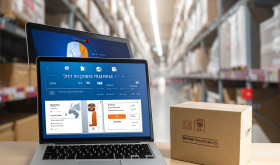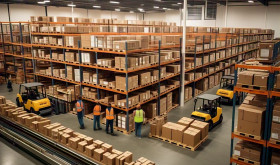
A Warehouse Management System (WMS) plays a crucial role for companies looking to boost warehouse operations, better manage inventory and speed up order fulfilment. But WMS options differ, and picking the right one hinges on your company’s specific requirements. For small shops, big online sellers, or third-party logistics (3PL) providers, the ideal WMS can transform your business. In this article, we will walk you through what to think about when choosing a WMS for various business types.
1.Getting to Grips with WMS Basics
A Warehouse Management System is software that aims to make warehouse operations better. It handles inventory tracking, order picking, packing, shipping, and reporting. By making these jobs automatic and smoother, a WMS can cut down on mistakes, boost output, and give you a clearer picture of your supply chain. But how well a WMS works depends on how well it matches what your business needs.
2.Figuring Out What Your Business Needs
Before you pick a WMS, you need to get a good grip on what your business requires. What a small shop needs will be very different from what a big factory or a third-party logistics company needs. Here are some big things to think about:
a) How Big Your Business Is and How Much It Handles
Small Businesses or Startups: Small companies process fewer orders and run simpler warehouse setups. A WMS for a small company should be quick to set up, easy to use, and able to grow with the business. You don’t need fancy features but should focus on systems that offer key functions like stock tracking and basic order handling.
Medium to Large Enterprises: For companies that handle more orders and have more complex operations, a more powerful WMS with advanced features is crucial. This system should offer things like predicting demand managing multiple warehouses and working with other business tools (like ERP or CRM systems).
Third-Party Logistics (3PL) Providers: 3PL companies run warehouses for many clients, which makes things more complex. A WMS for 3PL needs to support billing for multiple clients adaptable workflows and connect with various customer systems. The ability to scale and customize is also crucial to meet the different needs of each client.
b) Industry-Specific Requirements
Retail and E-commerce: A WMS for retail and e-commerce must handle large order volumes, work with multiple sales channels, and offer up-to-date inventory visibility. It should also include features to pick, pack, and ship as well as link up with e-commerce platforms and marketplaces like Shopify, Lazada, and Shopee.
Manufacturing: Manufacturers need a WMS that works with production schedules and inventory management. It should keep track of raw materials, work-in-progress goods, and finished products. Also, features like lot tracking serial number tracking, and quality control are key to comply with rules and trace products.
Food and Beverage: A WMS for this field must focus on handling perishable goods and making sure food safety rules are followed. Important features include tracking batches and expiration dates watching temperatures and following FDA and other regulations.
Healthcare and Pharmaceuticals: The healthcare industry needs tight inventory control and traceability. A WMS in this field should have features to control lots, manage expiration dates, and follow healthcare rules like FDA’s 21 CFR Part 11 for electronic records.
3.Evaluating WMS Features
When choosing a WMS, make sure it has features that match your business needs. Here are some key features to look for:
a) Inventory Management
Inventory accuracy forms the core of any warehouse operation. Your WMS should give you a real-time view of stock levels, track inventory locations, and have good stock replenishment systems. Features like barcode scanning, RFID tracking, and automatic cycle counting help to cut down stock differences.
b) Order Management and Fulfilment
A good WMS should make order management easier. Look for systems that work with different picking methods (like batch picking and wave picking) and route orders to ensure quick fulfilment. Another important feature is how well it connects with shipping systems (TMS) for smooth delivery.
c) Scalability
Your WMS should grow along with your business. Think about getting a cloud-based WMS that you can upgrade and expand to handle more users, warehouses, or a higher number of orders without any issues.
d) Integration Capabilities
Your WMS needs to work well with other key systems, like your ERP system, CRM platform, and online sales channels. Good integration makes sure data moves between systems without anyone needing to step in, which cuts down on mistakes and boosts productivity.
e) Reporting and Analytics
A WMS should give you in-depth knowledge about how your warehouse runs. Look for strong reporting and analytics features that help you keep an eye on important metrics such as how accurate orders are how fast inventory moves, and how well workers perform. Top-notch systems offer forecasting tools to improve warehouse layouts and staff placement.
f) Warehouse Automation Support
For companies thinking about automation, like robotic picking systems or conveyor belts, your WMS needs to support warehouse automation tech. Automation has an impact on productivity, cuts down errors, and reduces operational costs in bigger more complex warehouses.
4.Thinking About Budget and ROI
WMS prices can change a lot based on the features how it’s set up (cloud or on-site), and how much customisation you need. Small businesses might go for a cheaper ready-made solution, while big companies might need a customised system that fits with how they work.
When you’re looking at how much a WMS costs, think about what you’ll get back from it. A WMS can cut down on worker expenses, get orders right more often, and make customers happier. This can save you a lot of money over time. Make sure you pick a system that gives you the right mix of price and features for what you need.
5.Picking a Supplier
Selecting the right supplier is just as key as picking the WMS itself. Try to find suppliers with a good history in your field and good feedback from businesses like yours. Help and training are key to set things up, so check that your supplier offers full setup help and keeps giving tech support after that.
Conclusion
Picking the right WMS for your company is a key choice that has an impact on your warehouse operations, inventory management, and customer satisfaction. By knowing what your business needs—whether you run a small retail store, provide 3PL services, or manage a large manufacturing plant—and looking at WMS features, you can find a solution to boost productivity, cut costs, and grow with your business. Take your time to look at your options and pick a system that fits your long-term business plans.










